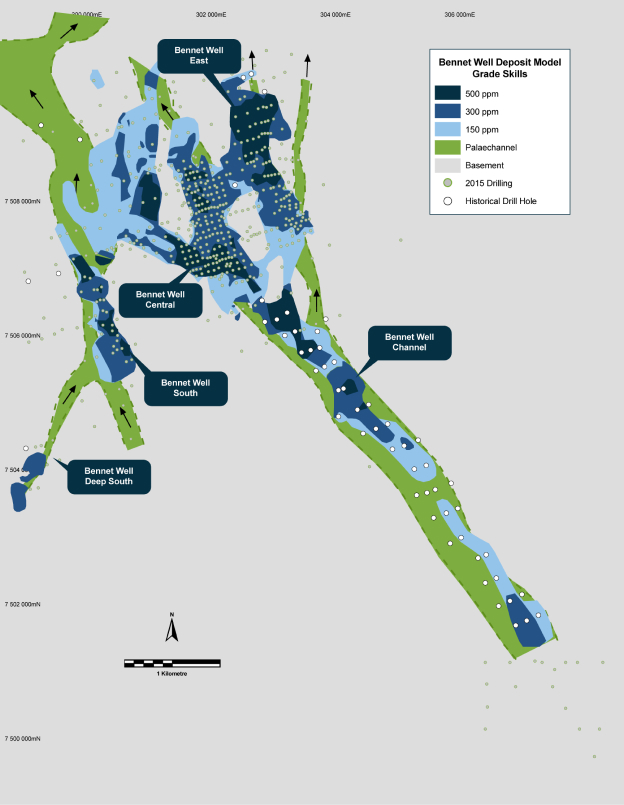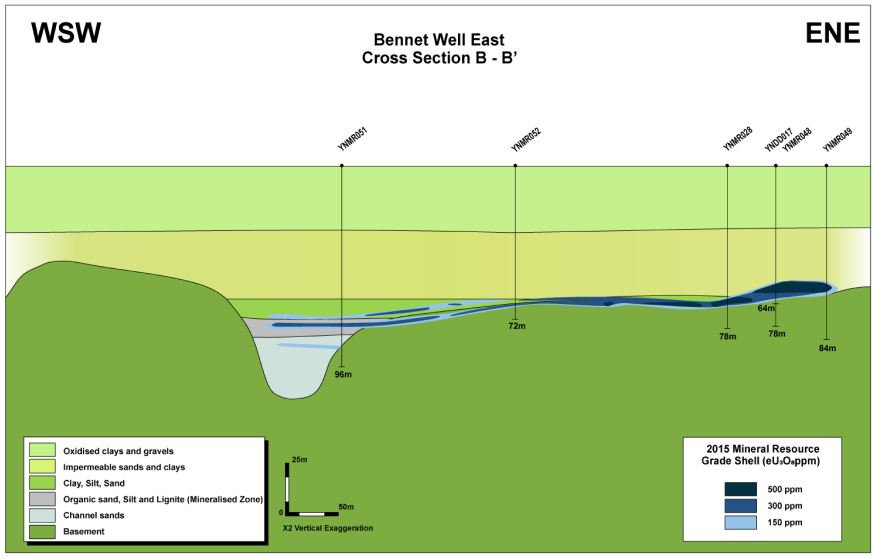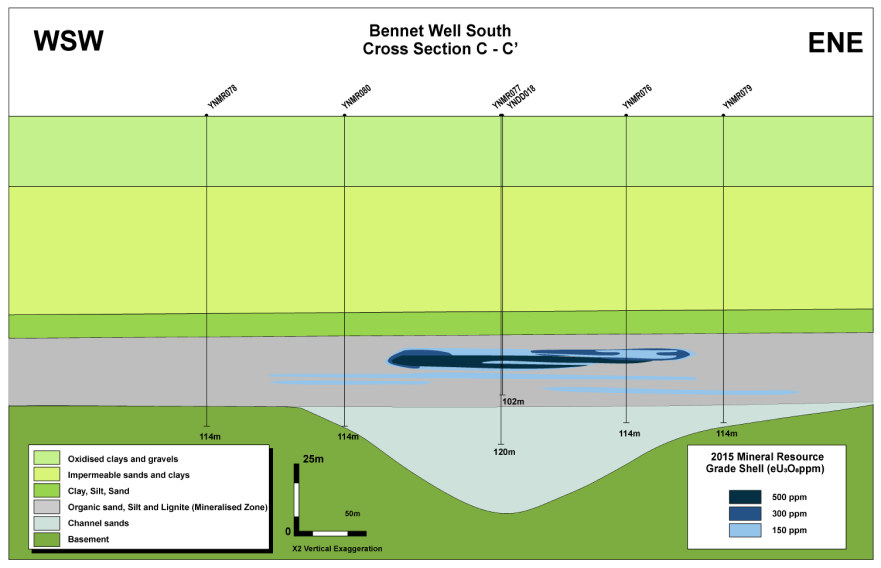Bennet Well Uranium Deposit
Bennet Well Uranium Deposit
Yanrey Uranium District,
Western Australia
The Bennet Well Deposit is located within Cauldron’s Yanrey Uranium Project in Western Australia and represents a significant resource with multiple high-priority extension targets.
The resource is a large, shallow accumulation of uranium oxide comprised of four spatially separated deposits – Bennet Well East, Bennet Well Central, Bennet Well South and Bennet Well Channel. Cauldron has reported a total Indicated plus Inferred Mineral Resource Estimate (JORC 2012) of 38.9 million tonnes @ 360 ppm eU3O8 for 30.9 million pounds (13,990 tonnes) of contained uranium oxide, using a cut-off of 150 ppm eU3O8.

Plan view of Bennet Well Mineral Resource (JORC 2012)
Mineral Resource (JORC 2012) containing a total combined 38.9 Mt at 360 ppm eU3O8, for total contained uranium-oxide of 30.9 Mlb (13,990 t) at 150 ppm cut-off.
Forms the anchor of the Yanrey Uranium Project in a newly-recognised, and potentially world-class, uranium province.
Highly successful technical studies (from the CSIRO) indicate mineralisation is amenable to either acid or alkali leaching by ISR mining (meaning a low capex and opex project development is possible, allowing the project to be in production throughout the uranium price cycle)
Strongly supports requirements for field testwork through Field Leach Trials.
Bennet Well Resource
Estimates
Ravensgate Mining Industry Consultants were commissioned to complete an upgrade to the Mineral Resource for the Bennet Well uranium deposit, after the completion of a mud rotary drilling program in late 2015. The report was prepared in accordance with the Australasian Code for Reporting of Exploration Results, Mineral Resources and Ore Reserves 2012 (JORC Code).
Ravensgate updated the Mineral Resource Estimate (JORC 2012) using a newly generated three-dimensional resource block model. This resource modelling was subsequent to a comprehensive revision of the stratigraphic setting completed in-house, following information provided by the 2013 and 2014 diamond drilling program and the mud rotary drill programs of 2014 and 2015, along with a reassessment of all previous drilling results, as summarised in the below table.
The Mineral Resource estimate for Bennet Well and its classification is shown in the first table below and summarised as a total Indicated plus Inferred Resource (JORC 2012) of 38.9 million tonnes at 360 ppm eU3O8 for 30.9 million pounds (13,990 tonnes) of contained uranium oxide, using a cut-off of 150 ppm eU3O8.
Deposit
Cutoff
(ppm eU3O8)
Deposit Mass (t)
Deposit Grade
(ppm eU3O8)
Mass U3O8 (kg)
Mass U3O8 (lbs)
Bennet Well_Total
125
39,207,000
355
13,920,000
30,700,000
Bennet Well_Total
150
38,871,000
360
13,990,000
30,900,000
Bennet Well_Total
175
36,205,000
375
13,580,000
29,900,000
Bennet Well_Total
200
34,205,000
385
13,170,000
29,000,000
Bennet Well_Total
250
26,484,000
430
11,390,000
25,100,000
Bennet Well_Total
300
19,310,000
490
9,460,000
20,900,000
Bennet Well_Total
400
10,157,000
620
6,300,000
13,900,000
Bennet Well_Total
500
6,494,000
715
4,640,000
10,200,000
Bennet Well_Total
800
1,206,000
1175
1,420,000
3,100,000
Deposit
Cutoff
(ppm eU3O8)
Deposit Mass (t)
Deposit Grade
(ppm eU3O8)
Mass U3O8 (kg)
Mass U3O8 (lbs)
125
22,028,000
375
8,260,000
18,200,000
150
21,939,000
375
8,230,000
18,100,000
175
21,732,000
380
8,260,000
18,200,000
200
20,916,000
385
8,050,000
17,800,000
250
17,404,000
415
7,220,000
15,900,000
300
13,044,000
465
6,070,000
13,400,000
400
7,421,000
560
4,160,000
9,200,000
500
4,496,000
635
2,850,000
6,300,000
800
353,000
910
320,000
700,000
Deposit
Cutoff
(ppm eU3O8)
Deposit Mass (t)
Deposit Grade
(ppm eU3O8)
Mass U3O8 (kg)
Mass U3O8 (lbs)
125
17,179,000
335
5,750,000
12,700,000
150
16,932,000
335
5,670,000
12,500,000
175
14,474,000
365
5,280,000
11,600,000
200
13,288,000
380
5,050,000
11,100,000
250
9,080,000
455
4,130,000
9,100,000
300
6,266,000
535
3,350,000
7,400,000
400
2,736,000
780
2,130,000
4,700,000
500
1,998,000
900
1,800,000
4,000,000
800
853,000
1285
1,100,000
2,400,000
Mineral Resource Estimate (JORC 2012) for Bennet Well, at various cut-off grades
The below images show sectional views through the Bennet Well deposit model, displaying the sedimentary geological units modelled from the recent core drilling. These units were modelled into three-dimensional wireframe solids, used to constrain grade in block model generation, and subsequently for estimation of the Mineral Resource.

Section view of Bennet Well Central mineralisation

Section view of Bennet Well East mineralisation

Section view of Bennet Well South mineralisation

Section view of Bennet Well Channel mineralisation
Bennet Well Amenable To
In-Situ Leaching
In-situ Recovery (ISR) is the most popular and fastest growing process route for global uranium production. Initial test work conducted by Cauldron and CSIRO suggest that Bennet Well is an excellent candidate for ISR development.
Permeability, porosity and density testing was completed by independent reservoir optimisation specialists, Core Laboratories Australia Pty Ltd using cores obtained from Bennet Well East and Bennet Well Central, affirming the suitability of ISR at the Bennet Well Deposit.
A 2020 study by the International Atomic Energy Agency and the Nuclear Energy Agency estimated that in 2019, around 57.4% of global uranium produced was via low pH ISR1, with that figure predicted to rise.
This method is proven in Australia, having been deployed at the Beverley, Four Mile and Honeymoon mines. ISR has numerous advantages, as listed below;
- Lower upfront capex
- Lower opex
- Lower ground disturbance
- No mining waste rock generated
CSIRO Metallurgical
Characterisation Research
Program
In late 2016, Cauldron successfully secured funding from the Commonwealth Scientific and Industrial Research Organisation (CSIRO) and the Minerals Research Institute of Western Australia (MRIWA) to initiate a deposit-focused investigation into the amenability of Bennet Well for uranium extraction by the In-Situ Recovery (ISR) method of mining. Phase 1 involved ten column leach tests on five mineralised zones which had been sampled by diamond drill core from the Bennet Well East and Bennet Well Central deposits. Both acid and alkali leaching solutions were tested, with oxidant added to each leachate mid-way through the leaching cycles. The ion exchange method of extraction was also tested, using nine commercially available ion exchange pellets to strip the uranium mineralisation from the pregnant liquor solution.
The second phase of the investigation (Phase 2) is aimed to support the activities of the proposed Field Leach Trials for which the approvals process was also commenced in 2016 and 2017. However, due to the change in State government and subsequent changes in policy towards uranium mining, these trials and Phase 2 activities are yet to be commenced.